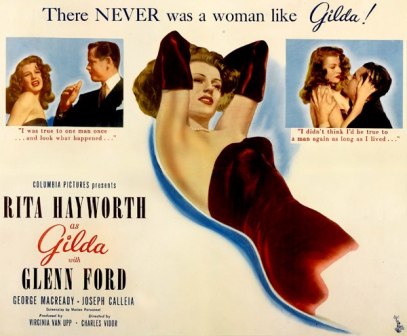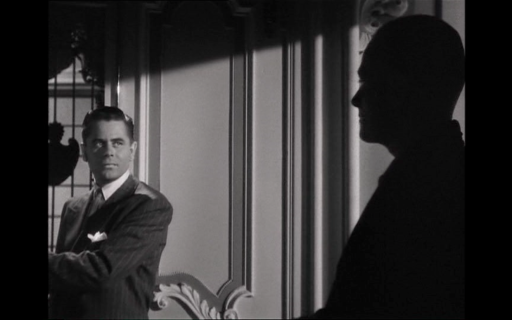During the TCM Classic Film Festival in 2012 we filled the Egyptian Theater to watch a sixty-six year old movie. While that’s nothing strange during the event or for the classic film fans in attendance, there was a palpable excitement about watching this particular movie, one most of us had seen countless times. On hand to introduce the movie that day was Debra Winger who spoke about her admiration for the film and next to me was a teenage boy who responded enthusiastically to nearly every scene. So, what is it about Charles Vidor’s GILDA (1946) that still elicits these responses?
Could it be that GILDA sits in the upper echelon of film noir, of classic glamour, of romance, of crime, of drama? Is it because it is a movie that defines a studio and an era? Is it because it brought an established star to a degree of superstardom few others would equal?
The answer is – all of that. AND because GILDA features one of the most iconic characters of all time who bleeds over into Hollywood reality from the moment she makes her entrance to when she performs in what is one of the most memorable scenes ever filmed. Unforgettable also in this movie is the love/hate – hate/love steamy chemistry between its stars, gorgeous photography by Rudolph Maté and wonderful dialogue.

Glenn Ford is Johnny Farrell, the narrator in this story, a man who owns his own destiny and makes his own luck. Until Gilda. Ford made several films noir of note and proved an especially appropriate noir protagonist. His image was consistent, that of a tough but vulnerable man who would prove easy prey for the femme fatales of the genre. Never is he weaker than while in the presence of Gilda.


George Macready is Ballin Mundson, the perfect combination of wronged man and murderous, swindling s.o.b., a man used to keeping possessions close – human or otherwise. Macready, who I must add is creepy in almost all I’ve seen him in, is particularly effective as Mundson as he plays him stiff and without an ounce of warmth. Mundson has one weakness – Gilda. However, even in his scenes with the woman he’s crazy about there’s a dangerous edge that grows steadily as the story advances. Maté’s cinematography, often placing Mundson in the shadows proves a very effective way to enhance this character’s menace.


Rita Hayworth is Gilda, the most famous role in her career and the peak performance of any star for GIs in WWII. Gilda’s allure, however, is ever-lasting. The provocative, beautiful, sophisticated and mysterious woman is given admiration by the camera so that she never goes out of style. The movie’s poster, which claims “There NEVER was a woman like Gilda!” still rings true. In some ways Hayworth as Gilda is classic Hollywood all by her lonesome. The iconic “Put the Blame on Mame” “clothed striptease” as many refer to it, still enchants and cannot be replicated by the best technology known to personkind or by any other human being. As film historian Richard Dyer put it, Hayworth as Gilda managed to project an “eroticism for herself as well as for the spectator.”
The screenplay for GILDA was written by Marion Parsonnet and adapted by Jo Eisinger based on an original story by E. A. Ellington. True to film noir-style storytelling, GILDA offers a complex and cynical tale common in post-war Hollywood. The story in the movie begins as the rich and dangerous-looking Ballin Mundson rescues down-on-his-luck professional gambler, Johnny Farrell by hiring him to work in his casino. That after Farrell cheats at blackjack in Mundson’s casino, which on some level impresses. At first Farrell is nothing more than added security, but soon works his way up to managing the establishment and looking after all of Mundson’s affairs and possessions. Little did Johnny Farrell know those possessions would include Mundson’s wife Gilda.
We are made privy to one of those “Oh, my!” screen moments when Farrell and Gilda first see each other in the movie. Mundson’s been away and upon his return summons Johnny to his house to show him something. The “something” is Gilda, Mundson’s new wife. Johnny’s heart is racing as he walks toward a room where he hears the sounds of a recording of “Put the Blame on Mame.” Farrell follows his boss and approaches the doorway to the inner sanctum as Mundson asks, “Gilda, are you decent?” Then one of filmdom’s best-known entrances is revealed, throwing her head back Gilda replies after a long, sensual and somewhat surprised look at Johnny, “Sure, I’m decent.”

We know instantly there’s history and heat between Gilda and Johnny. This can’t be good – but is oh, so good. From this point on things get darker. And hotter. Johnny is put in charge of keeping Gilda in check and she goes out of her way to make him jealous. It’s a sensual baiting game of the highest order. In the meantime Mundson is increasingly aware there’s a lot of hate going on between his wife and Johnny. And “hate is a very exciting emotion.”
Gilda: You do hate me, don’t you, Johnny?
Johnny: I don’t think you have any idea of how much.
Gilda: Hate is a very exciting emotion. Haven’t you noticed? Very exciting. I hate you too, Johnny. I hate you so much I think I’m going to die from it. Darling…
[they kiss passionately]
Gilda: I think I’m going to die from it.


Now things get really complicated as Mundson’s plans to rule the world by suspicious business dealings start to fall apart, which leads to his committing murder. One guesses it’s not the first time he’s done this, but it’s too close for comfort so he disappears, leaving a clear path for Gilda and Johnny. Things don’t get easier between the two after Ballin Mundson’s out of the picture, however. In fact, they get deeper and more disturbing and…for the rest you’ll have to watch the picture. If you haven’t seen this movie I can only say you must. GILDA is one of the classics that never gets old, that you can never see too many times and that you will never forget.
So, what is it about GILDA? Everything.
“If I’d been a ranch, they would’ve named me ‘The Bar Nothing'”






Terrific post as always. And wonderful photos too.
Thanks sweets! 🙂 I almost couldn’t stop with the pictures.
Aurora
When it comes to Gilda, ‘classic’ doesn’t quite cover it. Every time I watch it I’m impressed by Hayworth’s performance, by turns luminous, sassy and provocative. And that dress has to go down as one of my favourite costumes in cinema history…!
Isn’t “Ballin Mundson” one of the best movie names ever?
Yup, I think you’re spot on re: Gilda’s enduring qualities. I can only imagine how fab it would be to see this on the big screen.
George Macready played a similar type in Johnny Allegro in 1949 and his name was ‘Morgan Vallin’ !
Great post here! Gilda is actually a film I didn’t love from the start. But now, the more I watch it, the more I discover– in the plot as well as in the great performances of its stars. It just gets better and better! I would love to see this on the big screen!
Funny you should mention that. I find that’s the case with me and many film noirs – I’m so-so about them at first and then fall in love with them the more I see them.
Thanks so much for stopping in. 🙂
Aurora